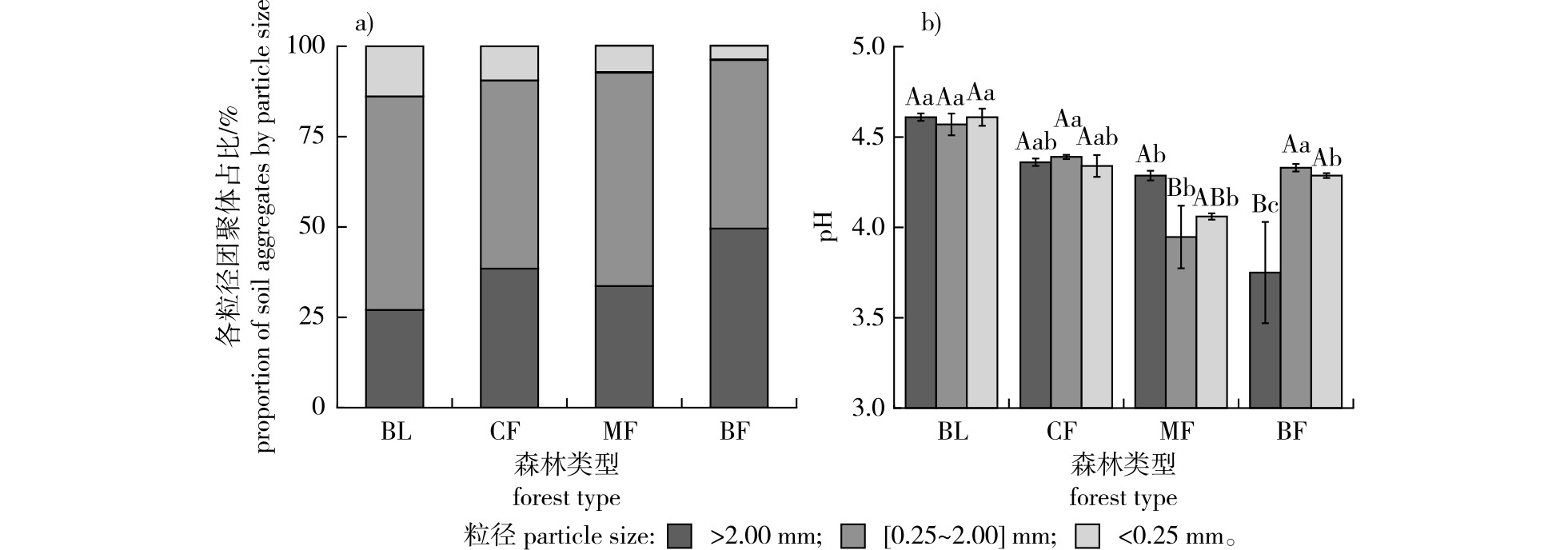【目的】探究不同森林类型中土壤团聚体磷形态特征、铁氧化物及解磷菌的分配情况,揭示磷素形态与森林类型转变关系,为理解红壤侵蚀区植被恢复下土壤磷循环的影响机制和土壤质量评估提供参考。【方法】在福建长汀南方典型红壤侵蚀区的裸地(BL)、针叶林(CF)、针阔混交林(MF)以及阔叶林(BF)的固定样地采集土壤样品,采用干筛法分析各粒径土壤团聚体组成,测定各粒级团聚体中磷素含量(质量分数)、铁氧化物含量(质量分数),并结合高通量测序测定解磷菌(PSB)群落结构和组成特征。【结果】①各土壤团聚体按粒径分为<0.25 mm(微团聚体),[0.25,2.00] mm(小团聚体),>2.00 mm(大团聚体),占比从低到高依次为微团聚体、大团聚体、小团聚体;以小团聚体占主导,其占比在 40%~53%。②森林类型转变过程中各粒径土壤团聚体无机磷含量以闭蓄态磷(O-P)为主,占无机磷总磷的50%以上,钙磷(Ca-P)则随着裸地到阔叶林类型的转变过程中呈现先增加后减少的趋势,且随着土壤团聚体粒径的减小,土壤团聚体中的铝磷(Al-P)和铁磷(Fe-P)含量(质量分数)增加。③在同一粒径土壤团聚体中,游离态氧化铁(Fed)含量(质量分数)随着裸地到阔叶林森林类型的转变总体上呈现减少趋势,而络合态氧化铁(Fep)含量(质量分数)总体上呈现增加趋势,无定形态氧化铁(Feo)含量(质量分数)在大团聚体中呈现增加趋势,在小团聚体和微团聚体中呈现先增加后减少再增加趋势。④随着土壤团聚体粒径减小,土壤解磷菌丰富度(Chao1和observed_species指数)总体上呈现增加的趋势,PSB多样性(Shannon、Simpon)随森林类型的转变总体呈现减少的趋势。【结论】随着植被类型从裸地转变为阔叶林,无定形态氧化铁和络合态铁增加,这有助于形成和维持较大的土壤团聚体。然而,解磷菌更偏好于微团聚体和小团聚体环境,这使得在成熟的森林生态系统中,较小团聚体在提供有效磷方面发挥着更为关键的作用。
【Objective】This research aims to investigate the characteristics of phosphorus forms in soil aggregates, iron oxids and the distribution of phosphate-solubilising bacteria in different forest types, and to reveal the relationship between phosphorus forms and forest type transition, so as to provide a reference for the understanding of the influence mechanism of soil phosphorus cycling in vegetation restoration and the assessment of soil quality.【Method】Soil samples were collected from fixed plots of bare land (BL), coniferous forest (CF), mixed coniferous broad-leaved forest (MF), and broad-leaved forest (BF) at the National Positioned Observatory for Red Soil Hills Ecosystems in Changting County, Fujian Province, China, and analysed the composition of soil agglomerates of all grain sizes by the dry sieve method, and the phosphorus content [total phosphorus (TP), effective phosphorus (AP), inorganic graded phosphorus, and the content of iron oxides (Fed), amorphous iron (Feo), and complex iron (Fep)] of aggregates of all grain sizes, respectively, were measured by the dry sieve method, and combined with the high-throughout sequencing for the determination of the characteristics of phosphorus-solbuiling bacterial (PSB) community structure and composition.【Result】(1)Soil aggregates were classified by particle size into <0.25 mm (micro-aggregates), [0.25, 2.00] mm (small aggregates), and >2.00 mm (large aggregates). The proportions from low to high were: micro-aggregates, large aggregates, and small aggregates. small aggregates were dominant, with a proportion ranging from 40% to 53%.(2) During the transition of forest types, the inorganic phosphorus content in soil aggregates primarily existed as occluded phosphorus (O-P), which accounted for over half of the total inorganic phosphorus. Calcium phosphorus (Ca-P) displayed an initial increase followed by a decrease. Moreover, the content of aluminum phosphorus (Al-P) and iron phosphorus (Fe-P) rose with the decrease in particle size of soil aggregates. (3) Within the same particle size of soil aggregates, free iron oxide (Fed) contents generally decreased, while complexed iron oxide (Fep) contents generally increased. The content of amorphous iron oxide (Feo) in >2.00 mm aggregates generally increased, and in [0.25,2.00] mm and <0.25 mm aggregates, it first increased, then decreased, and increased again. (4) A reduction in soil aggregate particle size was associated with an overall increase in the richness of PSB (Chao1, observed_species) and a general decrease in PSB diversity (Shannon, Simpson) with the transformation of forest types. 【Conclusion】As vegetation transitions from bare land to broad-leaved forests, the concentrations of amorphous iron oxides and complex iron forms increase, facilitating the formation and maintance of larger soil aggregates. However, PSB preferentially inhabit microaggregates and small aggregates, highlighting the critical role that these smaller aggregates play in supplying effective phosphorus within mature forest ecosystems.
 PDF(2435 KB)
PDF(2435 KB)


 PDF(2435 KB)
PDF(2435 KB)
 PDF(2435 KB)
PDF(2435 KB)
